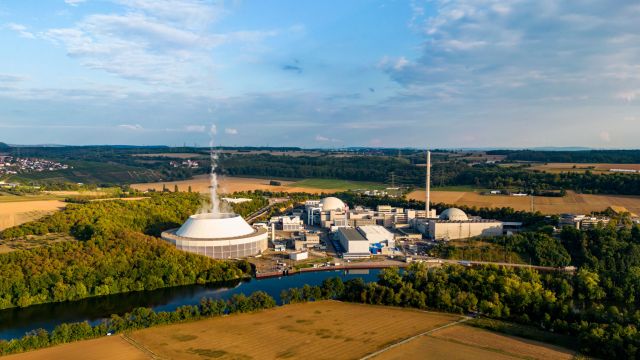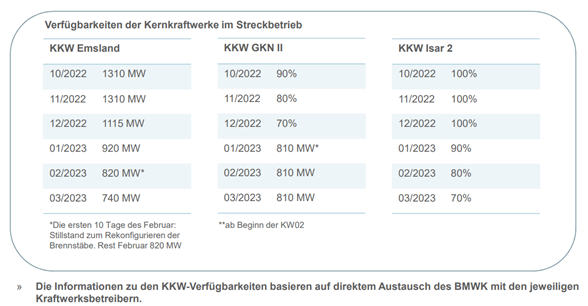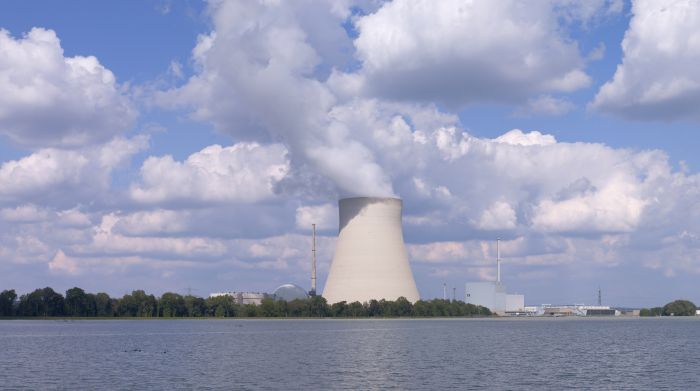
Fixed-term extension of operation: three German nuclear power plants to continue operating in stretch-out operation mode
Initial situation and decision in favour of extended operation
The stress test carried out by the German grid operators in autumn 2022 came to the conclusion that the continued operation of the nuclear power plants is a building block to stabilise the grids and thus increase energy supply security. This is mainly because the additional electricity generated by the nuclear power plants reduces the potential need for short-term electricity imports from abroad.
Against this background, on 17 October 2022, Federal Chancellor Olaf Scholz asked the Economics, Environment and Finance Ministries to create the legal basis for the fixed-term extension of operation of the three remaining commercial nuclear power plants. They are to remain in operation until 15 April 2023 at the latest. The Bundestag debated the draft amendment to the Atomic Energy Act on 9 November and voted to adopt it on 11 November.
These are the nuclear power plants in question: Emsland, Isar 2 and Neckarwestheim 2.
The three nuclear power plants are pressurised water reactors of the so-called Konvoi series. RWE's Emsland nuclear power plant was commissioned in 1988 and has a net electrical output of 1,335 megawatts (MW). Unit 2 of the Isar nuclear power plant, operated by the E.ON subsidiary PreussenElektra, was also commissioned in 1988 with a net electrical output of 1,410 MW. For several years in a row, it was the nuclear power plant unit with the highest annual production worldwide - measured in terms of its total energy output. The Neckarwestheim 2 nuclear power plant, first started up by EnBW in 1989, has an electrical output of 1,310 MW.
According to the grid operators, the three nuclear power plants can - depending on the scenario - supply an additional approx. 5 terawatt hours (TWh) of electrical energy in the period up to April 2023. Measured against the data of the Federal Statistical Office, this corresponds to about 1 per cent of the amount of electricity generated in Germany in 2021. For comparison: according to the Berlin grid operator, Berlin consumed about 12.6 TWh in 2021.
How will extended operation be implemented technically?
The law stipulates that no new fuel must be used. In view of the delivery times for fuel assemblies, this would at present not be possible anyway. Instead, the reactors are to be operated in so-called stretch-out operation mode. Stretch-out operation is a common and approved mode of operation that is used, for example, before refuelling and overall maintenance and inspection outages at the end of a fuel cycle. In the course of the fuel cycle, the proportion of fissile uranium in the nuclear fuel decreases continuously. At a certain point in time - experts refer to this as the "natural end of the cycle" - there is no longer enough uranium to generate 100 per cent power. As a result, the power output slowly decreases thereafter.
With the start of stretch-out operation, the reactor core loses up to 0.5 percent of its power per day (see figure), but overall additional electricity is produced in this way without the need for new fuel assemblies.

What about the safety of the nuclear power plants?
Reviewing safety is an ongoing process at nuclear power plants. This will also remain the overriding guiding principle during the continued operation of the three nuclear power plants. The requirements that must be met for a nuclear power plant to be considered "safe" are derived from the operating licences and the nuclear regulations - first and foremost the Atomic Energy Act and the Radiation Protection Act.
„"Since nuclear energy continues to be a high-risk technology, it must be shaped with particular care and precision, not least to take account of the protection of life and physical integrity (...)".“
Atomic Energy Act,19th amendment
Accordingly, the operator of a nuclear power plant must subject all safety-related components of the plant to so-called "in-service inspections" (ISI) at regular intervals. For example, emergency power diesels are tested one after the other at weekly intervals, i.e. one diesel per week. Other installations are tested during the annual overall maintenance inspection outage, some at longer intervals. The aim of these tests is to detect and rectify any potentially safety-relevant damage in a timely manner. The in-service inspections are also continued as scheduled during continued operation.
On top of the in-service inspections, pursuant to the Atomic Energy Act, the operators must carry out a periodic safety review (PSR) every 10 years. In addition to the safety inspections that are carried out on a regular basis, the PSR shows whether and, if so, how the safety of the plant can be further enhanced. This assessment is based on the operating experience of the last few years, an analysis of the actual condition of the plant, and a comparison with the currently applicable regulations and the current state of the art in science and technology.
If a PSR identifies potential for improvement that requires retrofitting, this is carried out during the annual overall maintenance inspection outage.
According to the Atomic Energy Act, the PSR may be waived if the operation of a plant is to be permanently discontinued within the following three years. This exception was used for the three plants. According to the current amendment to the Atomic Energy Act, no new PSR is required for the fixed-term extension of operation of the three nuclear power plants.
How are the operators actually preparing for the continued operation?
The three power plant operators EnBW, PreussenElektra and RWE have started planning for the fixed-term extension of operation following the German government’s decision. All decommissioning activities have been postponed and personnel planning has been adjusted.
In order to optimise electricity generation, it is planned to shuffle the fuel assemblies at the Neckarwestheim 2 nuclear power plant at the beginning of January 2023 and partially replace them with fuel assemblies presently located in the spent fuel pool. This is due to the fact that the plant will already be in advanced stretch-out operation at the end of 2022 with an output of 70 per cent. With this "refreshed" reactor core, electricity production is to be extended until the end of March and about an additional 1.7 TWh of electricity is to be generated.
The reactor core at the Emsland nuclear power plant is also to be optimised for extended operation. For this purpose, the reactor will be taken off the grid for about two weeks in January 2023. In the period up to April 2023, the plant should be able to supply around 1.7 TWh of electricity.
At the Isar 2 nuclear power plant, valves on the so-called pressuriser were overhauled in October 2022 during a one-week standstill of the plant. According to previous plans, the plant was supposed to reach 100 per cent capacity by 31 December 2022. The fuel in the reactor core therefore still contains sufficient fissile uranium, so that even without further optimisation, stretch-out operation is still possible until mid-April 2023. Converted, the fixed-term extended operation of Isar 2 corresponds to an additional electricity generation volume of about 2 TWh.
